 W
WArothron is a genus in the pufferfish family Tetraodontidae found in warm parts of the Atlantic, Indian and Pacific Ocean. These species are sometimes kept in aquaria. The largest species is A. stellatus, which can reach 1.2 m (3.9 ft) in length.
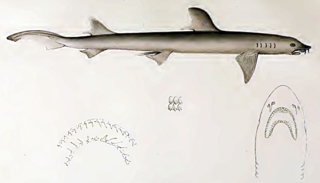 W
WThe barbeled houndshark is a species of ground shark and the only member of the family Leptochariidae. This demersal species is found in the coastal waters of the eastern Atlantic Ocean from Mauritania to Angola, at depths of 10–75 m (33–246 ft). It favors muddy habitats, particularly around river mouths. The barbeled houndshark is characterized by a very slender body, nasal barbels, long furrows at the corners of the mouth, and sexually dimorphic teeth. Its maximum known length is 82 cm (32 in).
 W
WThe blacktip shark is a species of requiem shark, and part of the family Carcharhinidae. It is common to coastal tropical and subtropical waters around the world, including brackish habitats. Genetic analyses have revealed substantial variation within this species, with populations from the western Atlantic Ocean isolated and distinct from those in the rest of its range. The blacktip shark has a stout, fusiform body with a pointed snout, long gill slits, and no ridge between the dorsal fins. Most individuals have black tips or edges on the pectoral, dorsal, pelvic, and caudal fins. It usually attains a length of 1.5 m (4.9 ft).
 W
WBombus ruderarius, commonly known as the red-shanked carder bee or red-shanked bumblebee, is a species of bumblebee found in Eurasia.
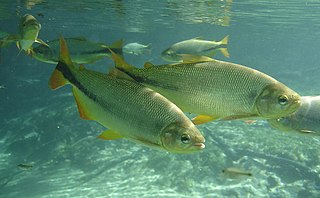 W
WBrycon is a genus of fish in the family Characidae found in freshwater habitats in Central and South America, ranging from southern Mexico to northern Argentina. Despite not being closely related to true trout, they are sometimes called South American trout. Members of the genus may also be referred to as piraputanga. They reach a maximum length of 11.9–79.5 cm (4.7–31.3 in) depending on the species involved. Some species perform seasonal breeding migrations.
 W
WThe bull shark, also known as the "Zambezi shark" in Africa, and "Lake Nicaragua shark" in Nicaragua, is a requiem shark commonly found worldwide in warm, shallow waters along coasts and in rivers. It is known for its aggressive nature, and presence in warm, shallow brackish and freshwater systems including estuaries and rivers.
 W
WCalophysus macropterus is a species of catfish of the monotypic genus Calophysus of the family Pimelodidae.
 W
WChiloscyllium is a genus of sharks in the family Hemiscylliidae.
 W
WThe daggernose shark is a little-known species of requiem shark, in the family Carcharhinidae, and the only extant member of its genus. It inhabits shallow tropical waters off northeastern South America, from Trinidad to northern Brazil, favoring muddy habitats such as mangroves, estuaries, and river mouths, though it is intolerant of fresh water. A relatively small shark typically reaching 1.5 m (4.9 ft) in length, the daggernose shark is unmistakable for its elongated, flattened, and pointed snout, tiny eyes, and large paddle-shaped pectoral fins.
 W
WLungfish are freshwater rhipidistian fish belonging to the order Dipnoi. Lungfish are best known for retaining primitive characteristics within the Osteichthyes, including the ability to breathe air, and primitive structures within Sarcopterygii, including the presence of lobed fins with a well-developed internal skeleton.
 W
WErethistes is a genus of South Asian river catfishes.
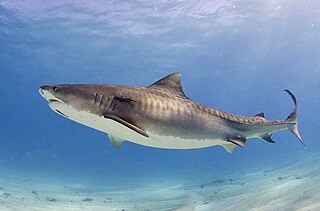 W
WGaleocerdo is a genus of requiem sharks that have lived since the Paleocene epoch. While these sharks were formerly diverse, only G. cuvier survives today.
 W
WThe Ganges shark is a critically endangered species of requiem shark found in the Ganges River and the Brahmaputra River of Bangladesh and India. It is often confused with the more common bull shark, which also inhabits the Ganges River and is sometimes incorrectly referred to as the Ganges shark. Unlike bull sharks, which need to migrate to salt water to reproduce, species in the genus Glyphis are true river sharks. The genus is currently considered to contain three recent species; genetic evidence has shown that both the Borneo river shark and Irrawaddy river shark should be regarded as synonyms of the Ganges shark, expanding the range of the species to Pakistan, Myanmar, Borneo, and Java. The species remains poorly known and very rare.
 W
WGinglymostoma is a genus of shark in the family Ginglymostomatidae. This fish lives in Brazil, the United States, Colombia, Ecuador, Cape Verde, Morocco, Mauritania, Senegal, the Gambia, Guinea-Bissau, Guinea, Sierra Leone, Liberia, Ivory Coast, Ghana, Togo, Benin, Nigeria, Cameroon, Equatorial Guinea, Republic of the Congo, Angola, the Democratic Republic of the Congo, Gabon, France, Spain, Nicaragua, Saint Lucia, Guatemala, Saint Vincent and the Grenadines, Guyana, Grenada, Suriname, French Guiana, Trinidad and Tobago, Dominica, Martinique, Dominican Republic, Costa Rica, Honduras, Haiti, Jamaica, Puerto Rico, El Salvador, Saint Kitts and Nevis, Turks and Caicos Islands, Guadeloupe, Montserrat, Antigua and Barbuda, Belize, Anguilla, Virgin Islands, Venezuela, Saint Martin, Sint Eustatius, Bonaire, Barbados, Bermuda, Aruba, Mexico, Cayman Islands, and Peru. There are two members in the genus. Members of this genus eat small fish and crustaceans, and are commonly quite lethargic unless provoked. Members of this genus have the ability to suck in water in order to remove snails from their shells in a manner that can be described as 'vacuum-like'.
 W
WThe Ganges shark is a critically endangered species of requiem shark found in the Ganges River and the Brahmaputra River of Bangladesh and India. It is often confused with the more common bull shark, which also inhabits the Ganges River and is sometimes incorrectly referred to as the Ganges shark. Unlike bull sharks, which need to migrate to salt water to reproduce, species in the genus Glyphis are true river sharks. The genus is currently considered to contain three recent species; genetic evidence has shown that both the Borneo river shark and Irrawaddy river shark should be regarded as synonyms of the Ganges shark, expanding the range of the species to Pakistan, Myanmar, Borneo, and Java. The species remains poorly known and very rare.
 W
WGoeldiella eques is a species of three-barbeled catfish that occurs in the Guianas and the Amazon basin of Brazil, Peru and Venezuela. This fish reaches a length of 28.9 centimetres (11.4 in) SL. It is the only species of its genus.
 W
WGymnophiona is the group of amphibians that includes the legless caecilians and all amphibians more closely related to them than to frogs or salamanders. The name derives from the Greek words γυμνος and οφις, as the caecilians were originally thought to be related to snakes. The body is cylindrical dark brown or bluish black in colour. The skin is slimy and bears grooves or ringlike markings; there are minute dermal scales.
 W
WHalichoeres maculipinna, the clown wrasse, is a species of tropical fish that lives throughout the Caribbean Sea and adjacent parts of the western Atlantic Ocean. It is a carnivorous, multi-colored wrasse that is common throughout its range.
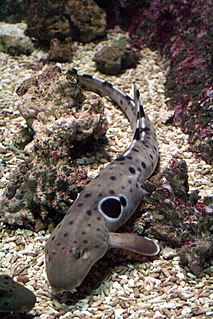 W
WHemiscyllium is a genus of sharks in the family Hemiscylliidae.
 W
WHeteropneustes, the airsac catfishes, is a genus of catfishes native to Asia. This genus is the only one in its family.
 W
WHimantura is a genus of stingray in the family Dasyatidae that is native to the Indo-Pacific. In a 2016 taxonomic revision, many of the species formerly assigned to Himantura were reassigned to other genera.
 W
WHylomys is a small genus of the family Erinaceidae. Hylomys species, like all species in the subfamily Galericinae, are known as gymnures or moonrats. Their closest relatives include the fossil Lantanotherium and Thaiagymnura and the living Neotetracus and Neohylomys.
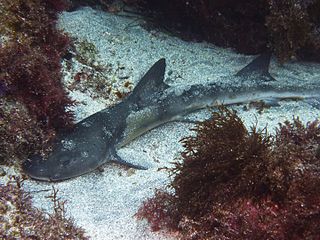 W
WThe Japanese topeshark is a species of houndshark, in the family Triakidae. It can reach a length of up to 1.1 m. It is found in the subtropical northwest Pacific from China, Taiwan, Korea, and Japan, between latitudes 40° N and 21° N.
 W
WThe Lamnidae are the family of mackerel or white sharks. They are large, fast-swimming sharks, found in oceans worldwide. The name of the family is formed from the Greek word, lamna, which means fish of prey, and was derived from the Greek legendary creature, the Lamia.
 W
WThe sliteye shark is a species of requiem shark, in the family Carcharhinidae, and the only member of its genus. It is found in the tropical waters of the Indo-West Pacific between latitudes 34° N and 30° S, from depths of 7 to 100 m. It can reach a length of about 95 cm.
 W
WThe ocellate river stingray, also known as the peacock-eye stingray or black river stingray, is a species of freshwater stingray in the family Potamotrygonidae. It was the first species to be described in the family and is also the most widespread, ranging throughout much of the Río de la Plata, Amazon, Mearim and Orinoco basins in tropical and subtropical South America. It is sometimes kept in aquaria.
 W
WSand sharks, also known as sand tiger sharks, grey nurse sharks or ragged tooth sharks, are mackerel sharks of the family Odontaspididae. They are found worldwide in temperate and tropical waters. The three species are in two genera.
 W
WThe bat-eared fox is a species of fox found on the African savanna. It is the only extant species of the genus Otocyon and considered a basal canid species. Fossil records indicate this canid first appeared during the middle Pleistocene.
 W
WPlatyrhina is a genus of rays in the family Platyrhinidae, containing three species. They are native to the warm-temperate to tropical marine waters in the western Pacific Ocean. They are little-known bottom-dwellers that feed on small invertebrates such as crustaceans, molluscs, and worms. The fanray is found inshore to a depth of 60 m on rocky or rock sandy bottoms.
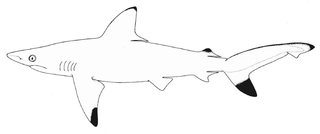 W
WThe Pondicherry shark is an extremely rare species of requiem shark, in the family Carcharhinidae. A small and stocky gray shark, it grows not much longer than 1 m (3.3 ft) and has a fairly long, pointed snout. This species can be identified by the shape of its upper teeth, which are strongly serrated near the base and smooth-edged near the tip, and by its first dorsal fin, which is large with a long free rear tip. Furthermore, this shark has prominent black tips on its pectoral fins, second dorsal fin, and caudal fin lower lobe.
 W
WThe porcupine river stingray is a species of river stingray in the family Potamotrygonidae, the type of the Potamotrygon genus. It is found in the basins of the Paraná and Paraguay River basins in South America. Most chemical weathering of minerals seems to take place in the upland drainage basins rather than on the floodplains, and most major solutes display conservative mixing in the river-floodplain system. The population in the Rio Negro basin was described as a separated species, P. wallacei, in 2016.
 W
WPristiophorus is a genus of sawsharks found in the Pacific, Atlantic and Indian oceans. Members of this genus differ from the Sixgill Sawshark (Pliotrema warreni) in having five gill slits. Their rostral sawteeth lack prominent transverse ridges on the basal ledges, and the large teeth are not posteriorly serrated.
 W
WRhamphichthys is a genus of South American sand knifefishes found in the Amazon, Orinoco, Río de la Plata and Paranaíba basins, as well as rivers in the Guianas. They are found along vegetated edges or near the bottom of rivers; they are often quite common in deep river channels. Rhamphichthys feed on small invertebrates. Little else is known about their behavior, but observations in aquariums indicate that they are nocturnal. They have a relatively long slender snout and depending on the exact species reach up to 26.5–100 cm (0.9–3.3 ft) in total length.
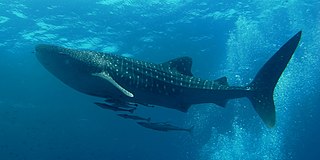 W
WThe whale shark is a slow-moving, filter-feeding carpet shark and the largest known extant fish species. The largest confirmed individual had a length of 18.8 m (62 ft). The whale shark holds many records for size in the animal kingdom, most notably being by far the largest living nonmammalian vertebrate. It is the sole member of the genus Rhincodon and the only extant member of the family Rhincodontidae, which belongs to the subclass Elasmobranchii in the class Chondrichthyes. Before 1984 it was classified as Rhiniodon into Rhinodontidae.
 W
WWedgefishes are rays of the family Rhinidae, comprising eleven species in three genera. Classified in the order Rhinopristiformes along with guitarfishes and sawfishes, they have also been known as giant guitarfishes or sharkfin guitarfishes.
 W
WThe guitarfish are a family, Rhinobatidae, of rays. The guitarfish are known for an elongated body with a flattened head and trunk and small, ray-like wings. The combined range of the various species is tropical, subtropical, and warm temperate waters worldwide.
 W
WRhynchobatus is a group of rays commonly known as wedgefishes in the family Rhinidae. They are found in the tropical and subtropical Indo-Pacific with a single species in the eastern Atlantic. All species in this genus are assessed as Vulnerable or Endangered by IUCN.
 W
WSciades is a genus of sea catfishes mostly found along the Atlantic Ocean and Caribbean Sea coasts of Central and South America. One species, S. dowii, occurs on the Pacific side from Panama to Ecuador, another, S. paucus, is a freshwater form found in Australia, while S. sona is a widespread species found along the Indian Ocean coasts of South Asia east into the Pacific to Polynesia. The genus Ariopsis has been merged with Sciades by some authorities.
 W
WThe speartooth shark is an extremely rare species of river shark, belonging to the family Carcharhinidae. It inhabits coastal marine waters and tidal reaches of large tropical rivers in northern Australia and New Guinea. Despite being a member of the river shark genus, it is also found in near-shore marine waters, favoring highly turbid environments over a wide range of salinities. This robustly built, gray-colored shark is characterized by a short and broad snout, tiny eyes, a relatively large second dorsal fin, and a black blotch beneath each pectoral fin near the tip. Another identifying trait is its teeth, which are large, triangular, and serrated in the upper jaw and narrow, spear-like, and serrated only near the tips in the lower jaw. Adults grow to about 2.6 m (8.5 ft) long.
 W
WThe spinner shark is a species of requiem shark, in the family Carcharhinidae, named for the spinning leaps it makes as a part of its feeding strategy. This species occurs in tropical and warm temperate waters worldwide, except for in the eastern Pacific Ocean. It is found from coastal to offshore habitats to a depth of 100 m (330 ft), though it prefers shallow water. The spinner shark resembles a larger version of the blacktip shark, with a slender body, long snout, and black-marked fins. This species can be distinguished from the blacktip shark by the first dorsal fin, which has a different shape and is placed further back, and by the black tip on the anal fin. It attains a maximum length of 3 m (9.8 ft).
 W
WThe zebra shark is a species of carpet shark and the sole member of the family Stegostomatidae. It is found throughout the tropical Indo-Pacific, frequenting coral reefs and sandy flats to a depth of 62 m (203 ft). Adult zebra sharks are distinctive in appearance, with five longitudinal ridges on a cylindrical body, a low caudal fin comprising nearly half the total length, and usually a pattern of dark spots on a pale background. Young zebra sharks under 50–90 cm (20–35 in) long have a completely different pattern, consisting of light vertical stripes on a brown background, and lack the ridges. This species attains a length of 2.5 m (8.2 ft).
 W
WSternopygus is a genus of glass knifefishes found in tropical and subtropical South America, and Panama. They inhabit a wide range of freshwater habitats, from fast-flowing rivers to essentially static waters in floodplains, and shallow habitats to the bottom of deep rivers. S. macrurus will even visit brackish mangrove to feed.
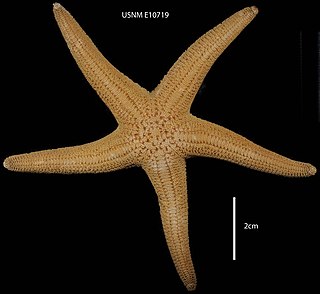 W
WStichaster striatus, the common light striated star, is a species of starfish in the family Stichasteridae, found in the southeastern Pacific Ocean. It was first described by the German zoologists Johannes Peter Müller and Franz Hermann Troschel in 1840.
 W
WSympterygia is a genus of fish in the family Arhynchobatidae found in oceans off South America.
 W
WTaeniura is a genus of stingrays in the family Dasyatidae. The species Taeniurops grabata and T. meyeni were formerly placed in this genus. However, phylogenetic research has shown that these two species are not closely related to T. lymma, and they have been assigned to a separate genus, Taeniurops.
 W
WThe threadfin acara, also known as Heckel's thread-finned acara, is a South American species of cichlid fish. It is the only member of the genus Acarichthys and is native to rivers in the Amazon and Essequibo basins in tropical South America, and has become established in southeastern Asia. It is sometimes found in the aquarium trade.
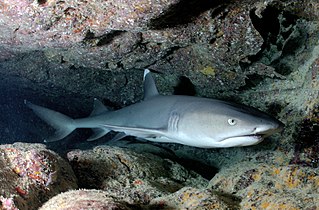 W
WThe whitetip reef shark is a species of requiem shark, in the family Carcharhinidae, and the only member of its genus. A small shark that does not usually exceed 1.6 m (5.2 ft) in length, this species is easily recognizable by its slender body and short but broad head, as well as tubular skin flaps beside the nostrils, oval eyes with vertical pupils, and white-tipped dorsal and caudal fins. One of the most common sharks found on Indo-Pacific coral reefs, the whitetip reef shark occurs as far west as South Africa and as far east as Central America. It is typically found on or near the bottom in clear water, at a depth of 8–40 m (26–131 ft).
 W
WTrygonoptera is a genus of round rays endemic to the waters around Australia. Müller and Henle defined Trygonoptera in 1841. It has often been considered synonymous with Urolophus, but this has been refuted by recent studies. Trygonoptera can be distinguished from Urolophus in that the outer rims of its nostrils are enlarged into broad, flattened lobes; the two also differ in aspects of the skeleton.
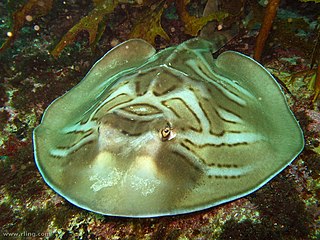 W
WTrygonorrhina, also known as the fiddler rays or banjo rays, is a genus of guitarfish, family Rhinobatidae. The two species are found along the eastern and southern coasts of Australia. They are benthic in nature, favoring shallow, sandy bays, rocky reefs, and seagrass beds. The eastern fiddler is found to a depth of 120 m and the southern fiddler to a depth of 180 m.
 W
WThe Urolophidae are a family of rays in the order Myliobatiformes, commonly known as stingarees or round stingrays. This family formerly included the genera Urobatis and Urotrygon of the Americas, which are presently recognized as forming their own family Urotrygonidae. Stingarees are found in the Indo-Pacific region, with the greatest diversity off Australia. They are sluggish, bottom-dwelling fish that have been recorded from shallow waters close to shore to deep waters over the upper continental slope. Measuring between 15 and 80 cm long, these rays have oval to diamond-shaped pectoral fin discs and relatively short tails that terminate in leaf-shaped caudal fins, and may also have small dorsal fins and lateral skin folds. Most are smooth-skinned, and some have ornate dorsal color patterns.